
WHAT WE HAD TO BUILD ON
Many of our key people in Apollo I, particularly on the spacecraft side, grew out of the old NACA, the National Advisory Committee for Aeronautics. We had the heritage of the airplane to work from, with all its methods of design, test, and operation. For the ballistic-missile programs of the early 1950s we had helped to develop solutions for reentry problems that were to have direct application to spacecraft design. But it was the launching of Sputnik I in October 1957 that put a new sense of value and urgency on the things we were doing. When one month later, the dog Laika was placed in orbit in Sputnik II, I was sure that the Russians were planning for man in space.It seemed to me that the United States would surely enter into space competition with the Soviet Union, and flying man into space would be a legitimate national goal.
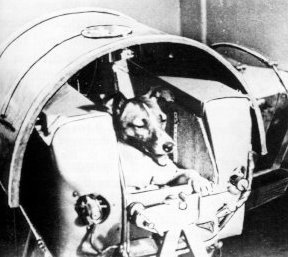 
|
| The Russians were ahead. A month after the 184-pound Sputnik I, they sent up the dog Laika (above left) in the 1120-pound Sputnik II. Three years later, on April 12, 1961, Yuri Gagarin (above right and below) became the first man to orbit the Earth. His Vostok I's payload was 10,417 pounds and his flight lasted 108 minutes. At this time, the United States was in the final stage of preparing for its first manned suborbital flight, on May 5, 1961. The physical hazards of weightlessness were then almost wholly unknown. |
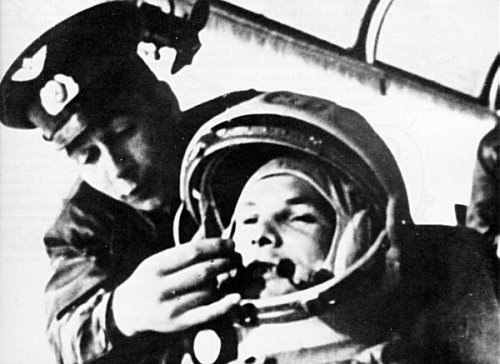
|
Thus it was that our small but creative group in NACA started working intensively on spacecraft-design problems. Most of the effort in those early days had been directed toward hypersonic gliders, or winged vehicles, that would fly at high Mach numbers and perhaps even into orbit. But our views were changing, and Harvey Allen of the Ames Laboratory was the first, to my recollection, to propose a blunt body for flying man in space. He suggested a sphere to enclose the man and said, "you just throw it", meaning, of course, launch it into space with a rocket. In March 1958, Max Faget presented a paper that was to be a milestone in spacecraft design. His paper proposed a simple blunt-body vehicle that would reenter the atmosphere without reaching heating rates or accelerations that would be dangerous to man. He showed that small retro-rockets were adequate to initiate reentry from orbit. He suggested the use of parachutes for final descent, and small attitude jets for controlling the capsule in orbit during retrofire and reentry. His paper concluded with a statement that: "As far as reentry and recovery are concerned, the state of the art is sufficiently advanced to proceed confidently with a manned satellite project based upon the use of a blunt-body vehicle."
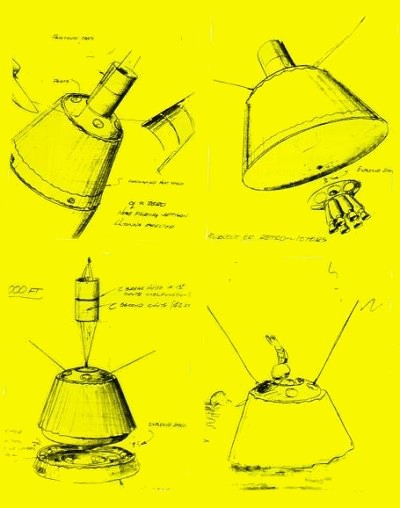
| Engineers brainstormed many ideas. These sketches illustrate some of them. In the upper left a spacecraft is shown still attached to its booster. It has jettisoned nose fairings and deployed its antenna. The drawing to the right of it shows the jettisoning of spent retrorockets as the spacecraft reenters the atmosphere. For reentry the blunt end is pointed in the direction of travel, thus serving as a heat shield. In the lower left sketch the heat shield is jettisoned just before splashdown. The final sketch shows the spacecraft floating safely in the water as an astronaut waves to the recovery team. Caldwell C. Johnson sketched these concepts in May 1958. |
Starting with the formation of NASA in October 1958, intense efforts were undertaken to create a manned space vehicle and flight organization capabie of flying man in orbit around the Earth. The plans for this vehicle were based on the blunt reentry body proposed earlier by Harvey Allen and Max Faget. A special team, the Space Task Group, was formed at Langley Field, Virginia, to manage this effort, and the McDonnell Aircraft Corporation won the competition to build what would be the Mercury spacecraft.
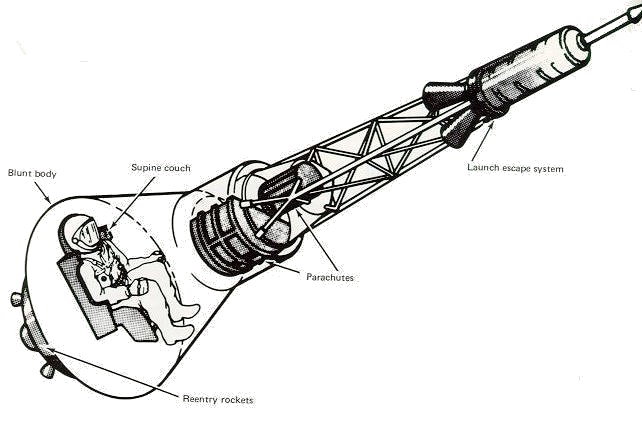
|
| Tests, redesigns, and more tests led to this basic configuration for manned spaceflight. A special escape system would pull the man from an exploding booster. Lying on a tailored couch, he would best withstand the g-loads of launch, abort, and atmospheric reentry. |
The heat shield was a slightly convex surface constructed of plastic and fiberglass material that would give out gas under intense heat, protecting itself from destruction. The conical afterbody was covered by shingles of high-temperature alloy similar to that used in turbine blades of jet engines. These shingles were insulated from the titanium pressure shell and they dissipated their heat by radiation. Parachutes were by far the lightest and most reliable means of making the final descent to Earth, and the parachute section was protected from heat by shingles of beryllium. Another key factor in the Mercury design was the supine couch for the astronaut. There had been considerable doubt that man could withstand the g-loads associated with rocket launching and reentry, particularly in abort situations. The form-fitting couch gave such well-distributed support that man could withstand over 20g without injury or permanent damage.
This concept of the Mercury capsule and, indeed, the whole plan for putting rnan into space was remarkable in its elegant simplicity. Yet its very daring and unconventional approach made it the subject of considerable controversy. Some people felt that such a means for flying man in space was only a stunt. The blunt body in particular was under fire since it was such a radical departure from the airplane. It was called by its opponents "the man in the can," and the pilot was termed only a medical specimen. Even Dr. Dryden, at the time the Director of NACA, labeled one early ballistic-capsule proposal the same as shooting a young lady from a cannon. However, he approved the Project Mercury design, since it was by then a complete system for orbital flight. The Mercury spacecraft and, in fact, Gemini and Apollo as well, were designed to land on the water because of the large water area which lay east of Cape Canaveral over the South Atlantic. lf an abort were required during launch, the spacecraft would have to survive a water landing; and this therefore became the best way to make all landings. It was easier to attenuate landing-impact forces in water landings, although the spacecraft was designed to survive a land impact without harm to flight crews.
The first astronauts were brought onboard the Mercury program in April 1959. They were volunteer military pilots, graduates of test pilot schools. Each was required to have a bachelor's degree in engineering or equivalent, and at least 1500 hours of jet time. Of the first group of 60 candidates called to Washington to hear about the program, more than 80 percent volunteered. All were of such high caliber that selection was difficult. However, I picked seven: three Air Force, three Navy, and one Marine, on the basis that the Mercury program would probably not give more than this number a chance to fly. These men were true pioneers. They volunteered at a time when our plans were only on paper and when no one really knew what the chance of success was. One had to respect their motivation and courage.

|
| The first seven American astronauts, chosen in April 1 959, were (from left, seated) Virgil I. Grissom, M. Scott Carpenter, Donald K. Slayton, and L. Gordon Cooper, Jr.; (standing) Alan B. Shepard, Jr., Walter M. Schirra, and John H. Glenn, Jr. They were test pilots who volunteered to fly a spacecraft -similar to the model shown- that had not yet been built. |
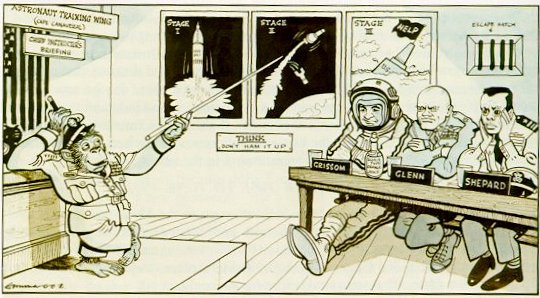
|
|
"Then, at 900.000 feet, you'll get the feeling that you must have a banana." (From Daily Mail, 23rd February 1960) Animals flew first, paving the way for man. Chimpanzees were physiologically manlike and easily trained. The Air Force's Aeromedical Field Laboratory provided them. |
We were to have many spectacular successes as well as failures in the Mercury program. However, we were able to learn from each failure, and fortunate in having these failures early in the program so that the astronauts and the animal passengers as weil were flown without mishap when their time came. Perhaps our most spectacular failure in Mercury came to be known as the "tower flight". In this sad affair, the escape tower, the parachutes, and the peroxide fuel were all deployed on the launching pad in front of the domestic and international press. A relatively simple ground-circuit defect in the Redstone launch vehicle caused the main rocket engine to ignite and then shut down after a liftoff from the launching pad of about two inches. The capsule events were keyed to the engine shutdown after having been armed by stage liftoff, as this was the normal procedure for sequencing unmanned flights. As you might expect, it was very difficult to explain this spectacular series of events to the working press, and to officials in Washington.
In those days an animal, in our case a chimpanzee, had to precede man into space. The flight of the chimpanzee Ham was a major milestone in our program. Here again we had some problems in the Redstone launch vehicle that resulted in a delayed pickup of the spacecraft, and water entered the spacecraft as a result of landing damage to the pressure shell. However, the animal performed admirably at zero gravity and was picked up unharmed. Ham became quite famous and proved to be a really lovable little fellow as well as a true pioneer.

| Custom-made couches were provided for the chimpanzees before their flights. Sensors attached to the animals and instruments in the spacecraft greatly reduced uncertainty about the effects of severe g-loads an the body of an astronaut. This medical research resulted in the design of a couch for the Mercury capsule that would distribute the occupant's weight and minimize acceleration loads on his body. |
All the things that were wrong with Ham's flight were corrected by hard work on the ground without further flight tests. We were now ready for our first manned suborbital flight and I recommended to Dr. Dryden and Mr. Webb that we were ready to go ahead. However, the Marshall Center required one more unmanned flight with the Redstone for booster development. It was during this period that the Russians sent Yuri Gagarin aloft in the Vostok spacecraft to become the first man in space.
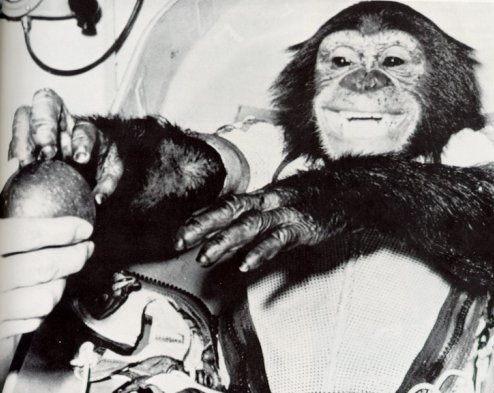
|
| A chimpanzee named Ham, shown hamming it up in the photo below, was "a delightful little fellow". The Mercury-Redstone 2 that carried Ham into space January 31, 1961, over-accelerated and ascended to a higher altitude than planned. Nonetheless, the capsule was recovered with Ham in good shape. He was then retired to a normal lifetime. Mercury researchers, remembering Ham fondly, occasionally visited him afterward. |
All of these events were occurring at the time that President Kennedy and his staff were taking over from the outgoing Eisenhower administration. Dr. Glennan, the Administrator of NASA during its first years, gave way to James Webb, who was to be the Administrator until October 1968. With the change came other events. Project Mercury was examined by the new head of the President's Science Advisory Committee, Dr. Jerome Wiesner, and a staff of medical and physical scientists. Our hearings before the Wiesner Committee went reasonably well until we came to convincing the doctors that it was safe for man to fly at zero gravity. Even though Ham, the chimpanzee, had fared well and was completely normal after his flight, the medical men on the committee were reluctant to accept this evidence that man could stand even 15 minutes of zero gravity. They were even concerned whether man could stand the mental stress of lying on top of a rocket and being blasted into space. However, we were able to convince Mr. Webb and Dr. Dryden that the program was sound, and they, in turn, convinced the President and his staff. It was at this time that Ed Welsh, Executive Secretary of the Space Council, remarked while Mr. Kennedy was pondering the impact of a failure, "Mr. President, can the country stand a success?"
On May 5, 1961, Alan Shepard became the first American to blast off from Cape Canaveral in a flight that was to be of great importance to our future programs. His flight in Freedoni 7 was followed by Gus Grissom in a Mercury capsule called Liberty Bell 7. Orbital flights of the Mercury capsule followed with a mechanical man and a chimpanzee named Enos. We were ready for manned flight into orbit. We were extremely fortunate to have six successful Atlas launch vehicles in a row to complete the Mercury program. John Glenn's Mercury-Atlas mission on February 20, 1962, was America's first orbital flight. We were to learn much from the flights of Glenn, Carpenter, Schirra, and Cooper that helped us in planning for the lunar program.
The exposure of man to zero gravity in these early manned flights was perhaps among the greatest medical experiments of all time. All the Mercury astronauts found the weightless state no particular problem. All returned to Earth with no medical difficulties whatever. This finding was so fundamental and straightforward that its importance was missed by many medical critics at the time. It now became simply a question of how long man could withstand weightlessness, and detailed medical measurements were made to cast light on how the body compensated for the new environment. Zero gravity produced some problems in locomotion and habitability, but not in man himself. We believed that even the longest flights of the future would probably require only methods of keeping the human body properly exercised and nourished in order to prevent a different reaction on returning to the gravity of Earth.
| Next |